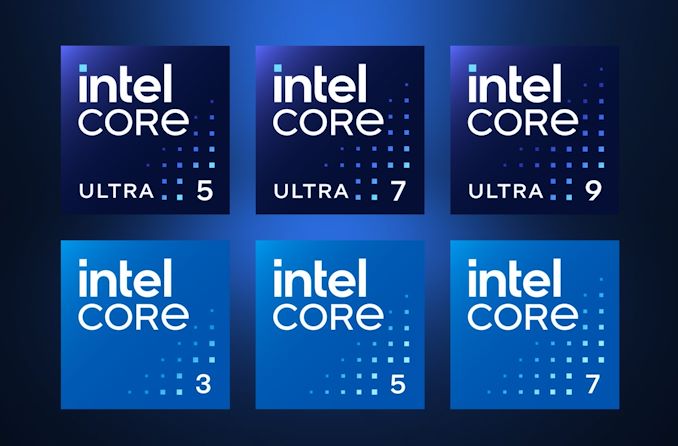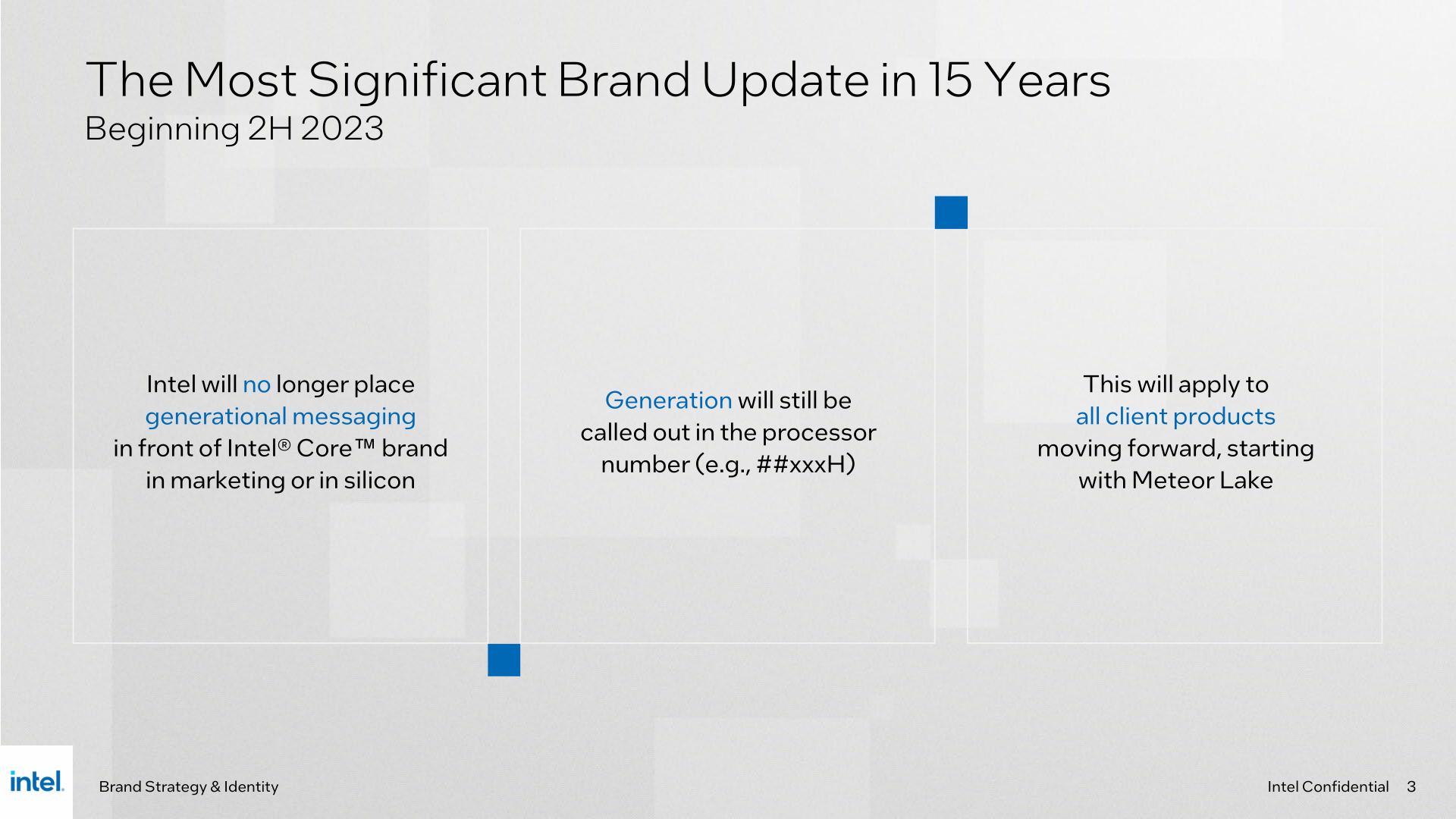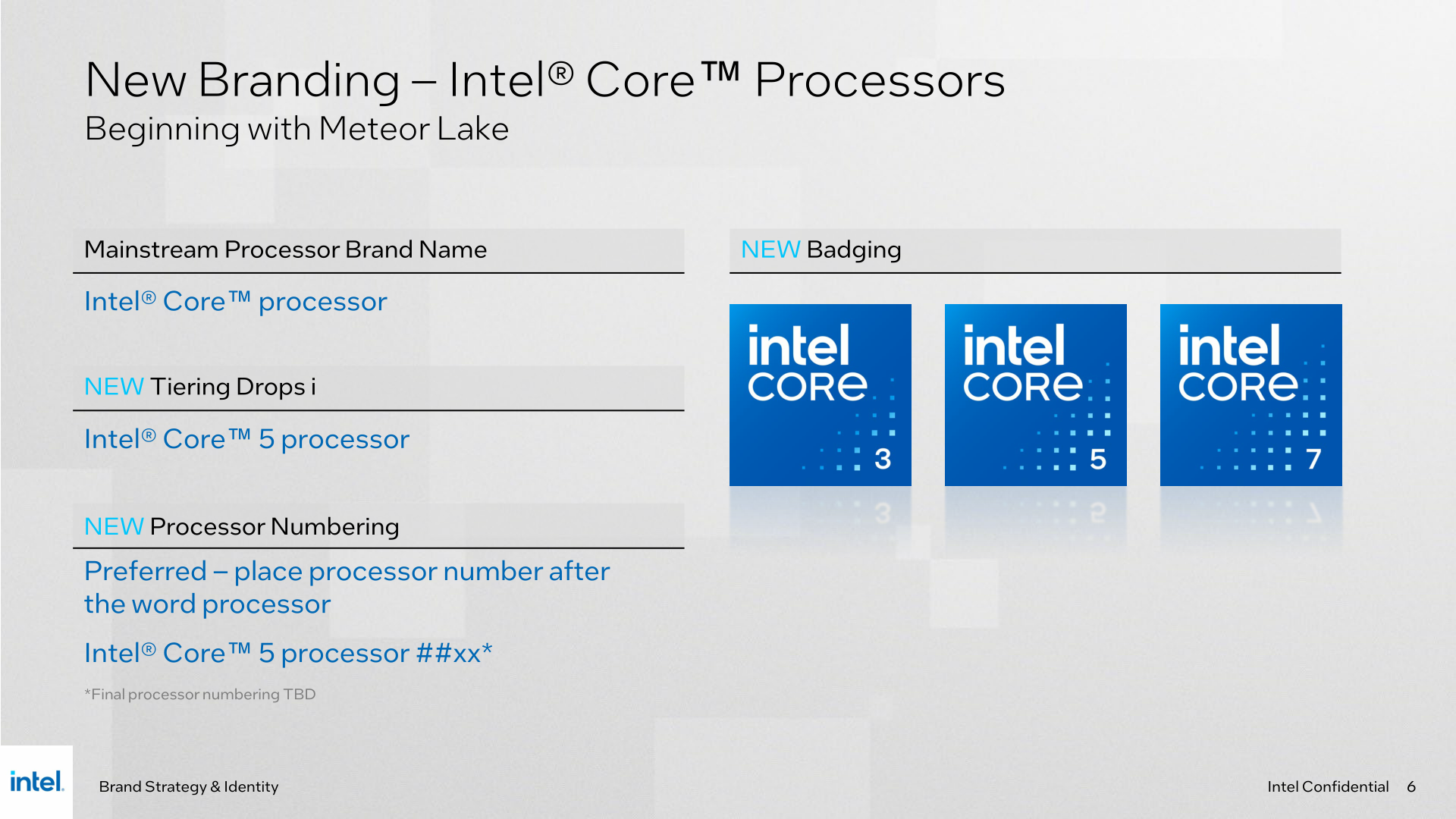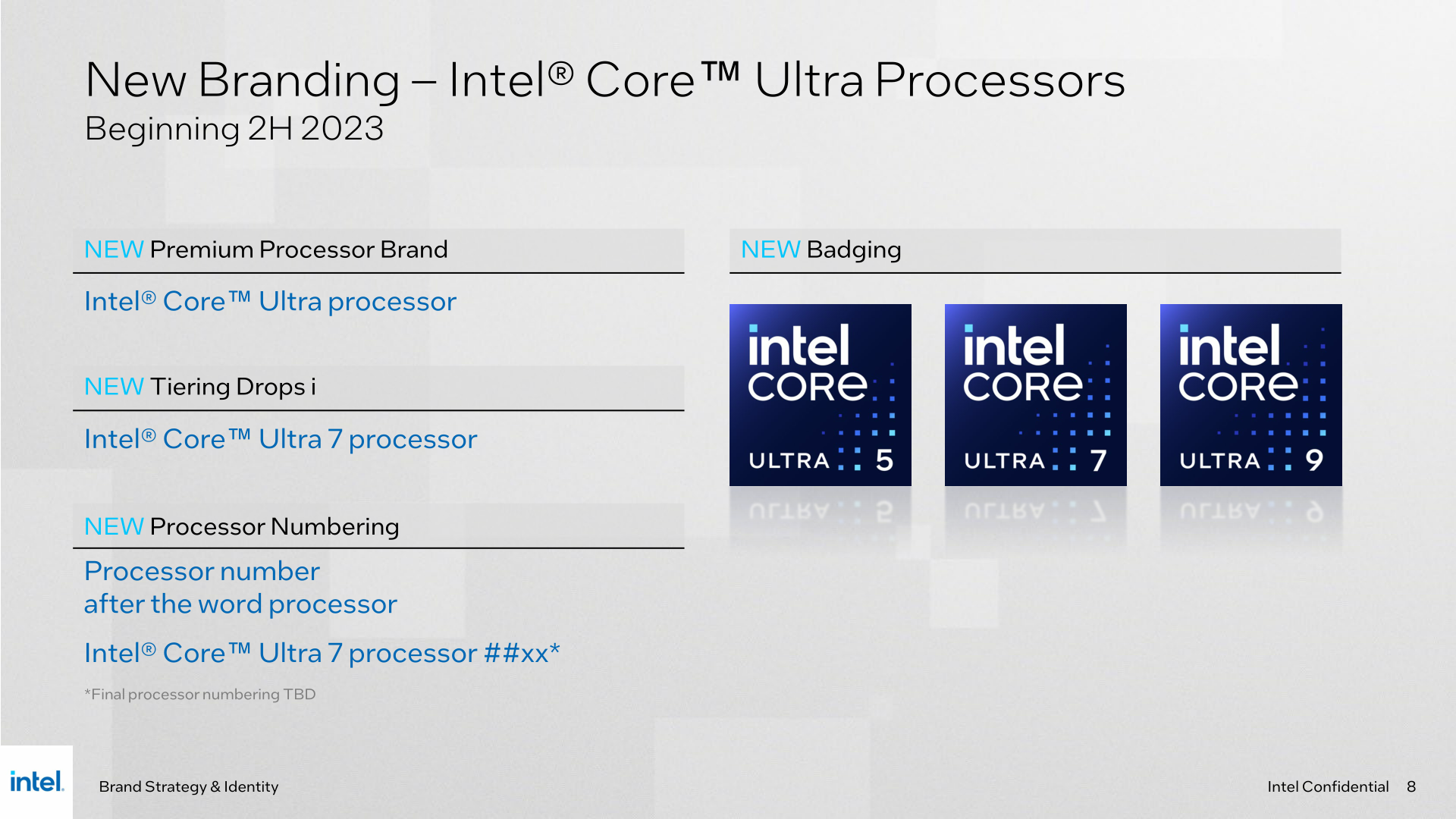Intel To Launch New Core Processor Branding for Meteor Lake: Drop the i, Add Ultra Tier
by Gavin Bonshor on June 15, 2023 9:00 AM EST
As first hinted at by Intel back in late April, Intel is embarking on a journey to redefine its client processor branding, the biggest such shift in the previous 15 years of the company. Having already made waves by altering its retail packaging on premium desktop chips such as the Core i9-11900K and Core i9-12900K, the tech giant aims to introduce a new naming scheme across its client processors, signaling a transformative phase in its client roadmap.
This shift is due to begin in the second half of the year, when Intel will launch their highly anticipated Meteor Lake CPUs. Meteor Lake represents a significant leap forward for the company in regards to manufacturing, architecture, and design – and, it would seem, is prompting the need for a fresh product naming convention.
The most important changes include dropping the 'i' from the naming scheme and opting for a more straightforward Core 3, 5, and 7 branding structure for Intel's mainstream processors. The other notable inclusion, which is now officially confirmed, is that Intel will bifurcate the Core brand a bit and place its premium client products in their own category, using the new Ultra moniker. Ultra chips will signify a higher performance tier and target market for the parts, and will be the only place Intel uses their top-end Core 9 (previously i9) branding.
Intel: A Brief History of the Core i Series
The Core i series debuted in 2008, around 15 years ago, marking the end of the first Core/Core 2 era and signaling a new dawn for Intel's client product lines. This change happened alongside the release of its 45 nm manufacturing process through the Nehalem architecture and covered products such as Celeron, Pentium Core, and the Xeon brands. More recently, in 2020, Intel initiated a more comprehensive overhaul of its corporate identity to modernize the messaging from a 50 year old company, the effects of which are still winding through the company today.
This revamp of Intel's branding has involved the introduction of new trademarks and logos characterized by cleaner typography and simplistic geometric backgrounds with a lighter blue color scheme. As part of this process, Intel has previously bid farewell to its long-established budget CPU brands, Pentium and Celeron. These branding changes were undoubtedly intended to convey a willingness to change, transcend, and solidify their position in an emerging market.
Going from the older Core Duo branding to the Core i3 series marked the dawn of Intel's modern low-end processor branding, with the quantitative markup of their other lineups into the Core i5 (mid-range) and the Core i7 series – which at the time, was reserved for Intel's flagship processors.
Going Forward: Deemphasizing Generational Branding
The latest branding change, as previously mentioned, is the biggest in the last 15 years of Intel. While some naming schemes can be confusing and cluttered (ahem, Xeons), Intel is aiming for something that's still reasonably clear for the client processors. Which is great timing, because the hardware underpinning them is about to get fairly complex with the transition chiplet-based Meteor Lake and its mix-and-match of dies built on the Intel 4 process and built over at rival-supplier TSMC.
First and foremost, under their new branding system Intel is doing away with leading generational branding. For the last decade plus, we've seen Intel slowly increment through their Core generations, such as 4th Gen Core, 9th Gen Core, 13th Gen Core, etc. Often, this was placed in front of the processor description (especially on OEM devices), giving us descriptions such as "Intel 11th Generation Core i3".
Under Intel's new branding change, the processor generation is being deemphasized – but not eliminated entirely. The processor model numbers themselves will still start with the generation as they do today, but that will be the only place where the generation will be consistently denoted. Generation as a leading indicator will be going away.
At this point, we don't know where Intel will start their latest numbering system from. While Intel could very well continue on from where they've left off, making the next parts the 14th Generation (and thus 14xxx model numbers), more likely Intel is going to use this as a chance to reset their generation count. The benchmark data leaks that caused Intel to initially comment on this matter back in April included mention of a 1003H chip, for what that's worth.
Intel Core 3, Core 5, and Core 7 for Mainstream: Dropping the Iconic 'i'
As part of the new rebranding, Intel is dropping the 'i' from their processor tiering system for client processors, starting with Meteor Lake and other products on the roadmap beyond this. This means that the Core i3, i5, and i7 naming structure becomes Core 3, 5, and 7, effectively dropping the 'i' moniker of the naming structure.
This means chips such as the Core i5 13600 would be named something like Core 5 13600 under the new naming convention. This doesn't constitute a massive change in the naming, but is significant as the 'i' has been an iconic moniker for its processors over the last 15 years.
Notably here, this tier of Core branding is what Intel considers their "mainstream" processors. It doesn't cover Core 9 in any way – that tier is reserved for Intel's premium "Ultra" brand.
Intel Core Ultra: Reserved For Premium Chips - Core Ultra 5, Ultra 7, and Ultra 9
Intel is also officially splitting off its premium client chips into their own sub-brand of sorts, giving them the new Ultra label. Intel's Core Ultra branding is reserved for their "premium" processors, which the company isn't strictly defining what that means in advance. So how this will fit into the Meteor Lake generation of processors remains to be seen. Though on the desktop, we wouldn't be the least bit surprised to see this replace (or go hand-in-hand with) Intel's traditional K/KS series SKUs.
Reading between the lines here, it's interesting to note that, unlike Intel's slide for mainstream processors, which says "Beginning with Meteor Lake", Intel's Ultra changes are "Beginning 2H 2023". There is still a lot of cloudiness within Intel's client chip roadmap when it comes to their desktop processor plans for the next year, and how Meteor Lake may (or may not) fit into those. So this slight distinction on when the branding begins may be a sign that Intel isn't intending to launch high-end Meteor Lake desktop processors – opening the door to a Raptor Lake refresh or the like.
Finally, following Intel's intended processor numbering scheme in the future, for both mainstream and Ultra chips, the processor model number will be after the word "processor". Intel's example is "Intel Core Ultra 7 processor [model number]" which isn't too much dissimilar to the current structure, albeit with the word 'Ultra' thrown in for good measure. This is to signify the target market of the processor, similar to how Intel used the Extreme moniker for their Core X-series processors.
Intel's Meteor Lake Cometh In H2'2023
The shift to the new branding and effectual removal of the 'i' from the said branding is interesting. While processor sales have declined over the last few years, the COVID-19 pandemic, the war in Ukraine, and a general economic downturn have worsened matters. It remains to be seen whether or not these new changes are designed to promote an uptick in sales, e.g., selling more chips, or whether or not they represent making a change due to the massive generational shift in how Intel will be fabbing its processors – both with regards to chiplets and the EUV-enabled Intel 4 process.
With Meteor Lake not expected to splash down from the skies until later in 2023 for mobile and perhaps later on (if at all) in 2024 for desktop chips, Intel's latest Intel 4 process represents a massive shift in Intel's processor technologies. Meteor Lake is the first in Intel's arsenal to use EUV lithography in the manufacturing process, including using a similar approach to using both performance (P) and efficiency (E) cores, much like we've seen from both Alder Lake (12th Gen) and the current Raptor Lake (13th Gen) processors.
Without diving much too into the meat of Meteor Lake and the advancements of what Intel 4 and TSMC's own processes bring to the table, our detailed coverage of Intel's upcoming Meteor Lake processors can be found below:
- Intel Discloses New Details On Meteor Lake VPU Block, Lays Out Vision For Client AI
- Intel Details PowerVia Chipmaking Tech: Backside Power Performing Well, On Schedule For 2024
- Intel Meteor Lake Client Processors to use Arc Graphics Chiplets
- Intel: Meteor Lake & Intel 4 Process Now Ramping for Production




















45 Comments
View All Comments
Drumsticks - Thursday, June 15, 2023 - link
Intel isn't exactly alone in that regard right now. Nvidia walked back their (terrible) 4080 12GB vs 4080 16GB issues. AMD is selling a 7730u right next to a 7540u, which is better? You probably would be forgiven thinking a 7730u is better, but since the 7000 series has frankensteined the uarch generation in the second digit, it's easy to forget that 7730 is zen 3. Most would probably see bigger number and more cores, and assume that each core isn't wildly different.Intel's naming scheme has never been simple, but at least they aren't selling a 13912k and a 13913k. As of late, it seems like Intel's the "least" responsible for tricking consumers into older products (again, looking at you, Ryzen 7 7730u).
s.yu - Thursday, June 15, 2023 - link
True. The competitors have been worse, but this new-old branding shadowing the moves of notably the smartphone manufacturers aimed at stupidifying their customers(e.g. "Xiaomi 13 Ultra"--"Intel 9 Ultra") is unimaginative to say the least.nonoverclock - Thursday, June 15, 2023 - link
Best thing to do is search for the product at ark.intel.com and see what it actually is. At least that's a clear enough way to figure out what it is.Silver5urfer - Thursday, June 15, 2023 - link
They are worst and totally incompetent. The only detail you have to look is into their Twitter profiles and their nonsensical ramblings and their political leanings. For this if you check the old April article you can see the person incharge of this move, a guy named Bernard.The primary reason I can guess is Intel is transforming, because most of the fools at Intel are neck deep into Apple fanaticism so they are obsessed in creating the products or the PR like them. Proof is Intel's ARMesque garbage Biglittle approach, they want the dumbest consumers out there so that they can rip them off. E cores add that chaos to the mix.
Adding Ultra makes them sound cooler, also since LGA processors shipping volume is far far lower than that of the BGA processor lines Intel wants to make it appealing to the dumb audience, sorry it's a fact most of the modern consumers do not even care to own a PC, they are content with their disposable mobile. So an i series seen by those tunnel vision PR heads is too technical so they are abandoning it.
lmcd - Monday, June 19, 2023 - link
Intel's SKU count is because they are flagrantly transparent. Intel's Ark should be easily replicable from Nvidia and AMD as well, but instead I have to hope someone accurately updated wikichip if I want to figure out what garbage my relative bought from my phone.nandnandnand - Thursday, June 15, 2023 - link
Guess: "Ultra" will be used for processors with the "Adamantine" L4 cacheHresna - Saturday, June 17, 2023 - link
Yeah this has been confusing me too, since clearly Core 5 and “Core 5 Ultra” will coexist so it’s not clear what the difference is; thought the Anand coverage would at least have speculated if it wasn’t explained in the release. Could it be different node/architecture even? The ultras are “current gen” and the non ultras are improvements on older tech?iampivot - Thursday, June 15, 2023 - link
This one goes all the way to 11.Silver5urfer - Thursday, June 15, 2023 - link
Most dumbest move by Intel. Not that I'm surprised because I knew the moment when I saw this in April coming from their inept PR beancounter teams running the show, esp the April article which AT had mentioned the actual exec who is spearheading this move, psst - they use Twitter to spread their political ideologies that alone discredits their professionalism you are working for a Technological corporation not some BS show.That said Intel has been addicted to BGA a lot, and with Intel getting the L from Apple they want to really lure everyone on the BGA land to their side, so they are going for the dumbest thing and dumbing down their own achievements at the Intel HQ. Like Intel Core i series is the literal signature of the Intel's growth in the x86 industry and the CPU sector entirely, every single person knows the Core i7, i9 they know they are buying top end of the stack. Intel diluted with U branding but it was expected that PR teams will fleece the consumers. I can smell the Ultra BS to even do a more ridiculous rip off.
However this thing is dropping the whole Intel brand to some generic rip off Ultra is a Real shame.
Also if you noticed Intel removed their easter eggs from the CPU stickers ever since they started to change their logos from 11th gen. The signature Intel with the swirl is gone and replaced by a dull lifeless typeface. Intel used to have the CPU holographics on the stickers PLUS on the backside of the actual CPU too a nice nod to the Engineers who built these processors. They killed it all since 10th gen onwards (this one still had swirl good ol logo but no easter egg) and from 11th it became worst.
All in all this not only signifies a lot has changed at Intel. Not just Intel everyone is obsessed with Apple, look at MS Windows 11 it looks like a cheap Mac clone and a simplified dumbed down UI and power user features too, same for Google Android OS too. The rot is too deep in the Silicon Valley sadly. Intel killed even Optane. They sacked the L4 eDRAM since Broadwell and only to bring it back now with MTL due to AMD's X3D. They have been bleeding talent left and right, now trying to crawl proves their Incompetence in passionate innovation and everything. To make things worse Gelsinger has investments in Cyberreason which is a division of former Unit 8200 who made the famous NSO Spyware, even Apple has ties to NSO. The Pegasus spyware. This company is on a downhill, latest was that x86 with 32Bit removal, another Apple inspiration to make things obsolete and compromised from the design. Sadly the CA state has become this sad state of affairs and it has ruined the tech.
End of an era.
goatfajitas - Friday, June 16, 2023 - link
Remember that one time when they didn't innovate at all from 2010 to 2020?- That was awesome